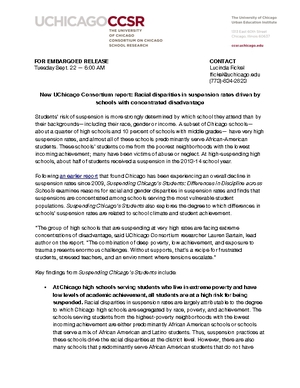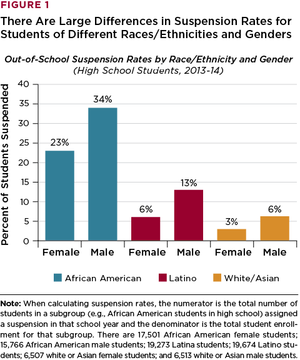1. What drives disparities in suspension rates in the district—differences by students’ backgrounds within schools, or differences in general practices across schools?
2. In what ways do schools differ in their use of exclusionary discipline practices?
3. How is the use of exclusionary practices related to school climate and student learning?
4. To what extent are suspensions accompanied by supplemental supportive practices, and are these practices related to school climate?
5. How do discipline practices in the middle grades differ from high school?
Students' risk of suspension is more strongly determined by which school they attend than by their backgrounds—including their race, gender or income. A subset of Chicago schools—about a quarter of high schools and 10 percent of schools with middle grades—have very high suspension rates, and almost all of these schools predominantly serve Black students. These schools' students come from the poorest neighborhoods with the lowest incoming achievement; many have been victims of abuse or neglect. At high-suspending high schools, about half of students received a suspension in the 2013-14 school year.
This report examines reasons for racial and gender disparities in suspension rates and finds that suspensions are concentrated among schools serving the most vulnerable student populations. It also explores the degree to which differences in schools' suspension rates are related to school climate and student achievement.
Key findings:
- At Chicago high schools serving students who live in extreme poverty and have low levels of academic achievement, all students are at a high risk for being suspended. Racial disparities in suspension rates are largely attributable to the degree to which Chicago high schools are segregated by race, poverty, and achievement. The schools serving students from the highest-poverty neighborhoods with the lowest incoming achievement are either predominantly Black schools or schools that serve a mix of Black and Latino students. Thus, suspension practices at these schools drive the racial disparities at the district level. However, there are also many schools that predominantly serve Black students that do not have high suspension rates; the students in these schools tend to have high prior achievement or come from neighborhoods without substantial poverty.
- Students with a history of abuse or neglect are at particularly high risk for being suspended. For the first time, researchers were able to combine discipline data with child welfare data and found that almost a third of the students with a history of abuse or neglect were suspended in the 2013-14 school year.
- Students with a history of abuse or neglect are concentrated in schools with high suspension rates; in almost all high-suspending high schools, at least 10 percent of students had a documented history of abuse or neglect.Schools with higher suspension rates have worse climates for learning, even when compared to schools serving similar student populations. Frequent use of suspensions is related to greater disorder in schools and with less positive peer relationships among students. District policies discouraging suspensions, shortening their length, and encouraging alternative discipline approaches such as restorative justice have mixed effects. Shortening the length of suspensions, which mostly affected schools with the highest suspension rates, was associated with improved attendance but worse school climate. Restorative practices that accompany suspensions have a more positive association with climate in schools with lower suspension rates, suggesting that policy solutions are particularly difficult to implement effectively in schools with the most disciplinary problems.
- Disparities also exist because Black boys are suspended at higher rates than other students in their school. At schools that have racial/ethnic diversity, suspension rates for Black boys are about 13 percentage points higher than the suspension rates for other students who attend the same school.









